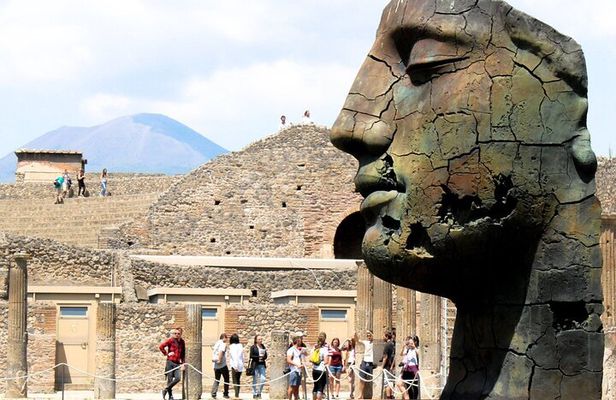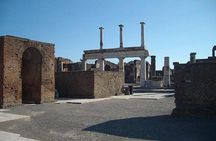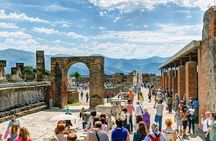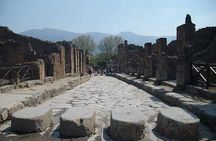
No expiration date
Easy refund
Free exchange
Easy booking
Guided Tour of Pompeii and Herculaneum with Lunch and Ticket
$198.03
This is an experience gift voucher. The recipient will book the experience after
they redeem the gift voucher.
Overview
The eruption of the volcano in 79 A.D. burned and buried the cities of Pompeii and Herculaneum, but after the catastrophe the ruins were preserved almost perfectly under layers of volcanic ash. Thousands of years later, you can still explore the spooky streets and get inside houses, toilets, and restaurants during the tour along with our authorized guides. Our tour was created to have a unique memory and discover the ancient cities of Pompeii and Herculaneum with their hidden treasures declared World Heritage by UNESCO. Immerse yourself in the tragic history of the region and then end the day with a delicious Italian lunch in a traditional restaurant on the slopes of Vesuvius.
• Explore the ruins of Pompeii and Herculaneum with a local expert archaeological guide
• Semi-private and air-conditioned buses
• Entrance reserved in Pompeii and Herculaneum
• Wine tasting and lunch with local products
• Explore the ruins of Pompeii and Herculaneum with a local expert archaeological guide
• Semi-private and air-conditioned buses
• Entrance reserved in Pompeii and Herculaneum
• Wine tasting and lunch with local products
—
The experience offers several options. This price includes:
Shared Tour from Sorrento
Services Included:: Round trip transfer from from Sorrento
Guide full day
Pompeii & Herculaneum entrance fee
Light Lunch & wine tasting
Shared Tour
Duration: 9 hours
Light Lunch & wine tasting
Departure from Sorrento: Meeting point at 08:00 a.m. by the BAR KONTATTO - Corso Italia n. 257 Sorrento
Minibus up to 29 people
Starting point:
Bar Kontatto, Corso Italia, 257, 80067 Sorrento NA, Italy
Services Included:: Round trip transfer from from Sorrento
Guide full day
Pompeii & Herculaneum entrance fee
Light Lunch & wine tasting
Shared Tour
Duration: 9 hours
Light Lunch & wine tasting
Departure from Sorrento: Meeting point at 08:00 a.m. by the BAR KONTATTO - Corso Italia n. 257 Sorrento
Minibus up to 29 people
Starting point:
Bar Kontatto, Corso Italia, 257, 80067 Sorrento NA, Italy
Tour guide
Language: English
Human tour guide
Duration: 9 hours
The experience offers several options, check yours above
- Pick-up from our meeting point
- Headphones for all passengers in Pompeii and Herculaneum
- A/C Minibus
- Entrance tickets to Pompeii and Herculaneum
- Light Lunch and Wine Tasting
- Authorized official English speaking guide
Meeting point
This is the meeting point in Naples (Please choose the Naples Departure's Option)
This is the meeting point in Sorrento (Please choose the Sorrento Departure's Option)
Return details
This is the meeting point in Naples (Please choose the Naples Departure's Option)
This is the meeting point in Sorrento (Please choose the Sorrento Departure's Option)
-
Pompeii Archaeological ParkThe ruins of Pompeii are a vast archaeological site in the southern Campania region, near the coast of the Gulf of Naples. Once a thriving and sophisticated Roman city, Pompeii was buried under meters of ash and pumice after the catastrophic eruption of Mount Vesuvius in 79 AD. The preserved site features remain of excavated streets and houses that visitors can freely explore.
-
Foro de PompeyaThe Civil Forum represents the center of the daily life of the city, all the main public buildings for the administration of the city and justice, for the management of business, for commercial activities, such as markets, overlook it, in addition to the main places of city worship.
-
Tempio di Giove CapitolinoThe Temple of Jupiter dominates the northern side of the Forum, and Vesuvius rises spectacularly behind it. With the deduction of the colony (80 BC) the temple was the subject of a radical renovation and became a real Capitolium, with the three cult statues of Jupiter, Juno and Minerva, which imitated those of the Capitolium in Rome, placed on a high base, so as to make them visible to those passing through the Forum square.
-
MacellumThe Macellum consists of a tuff Quadri-porticus with a hall for worship in an elevated position on the eastern side, in line with the entrance. The Macellum of Pompeii was nothing more than the city market where people could buy food. Located north-east of the Forum, the complex had to remain out of the way from the square so as not to create too much crowding, given the high number of people who certainly frequented it. The walls of the porticoes were decorated with scenes from daily life, such as selling fish and poultry, and mythological subjects.
-
Via dell’Abbondanza“Via dell 'Abbondanza” is one of the main streets of the ancient city of Pompeii, in Campania, which connected the Forum with the Amphitheatre.
-
Stabian Baths (Terme Stabiane)The Stabian Baths were built at different times. The initial phase of construction dates back to the 4th BC. The main entrance by via dell'Abbondanza leads to a large courtyard. The pool is found to the left, whereas a colonnade is found to the right, which leads to the men's quarters, which are split into the apodyterium, with the frigidarium, which leads to the tepidarium and then to the calidarium.The heating was guaranteed by a piping system in the walls and double floors that circulated the hot air coming from the furnaces and from mobile braziers. The women's quarters, close to the men's quarters, were split the same way in the apodyterium, tepidarium and calidarium. However, all were smaller and had no rich decorations as the men's quarters. The baths that we can admire today were built in the 2nd century BC, a period in which Pompeii underwent a major building renovation. In the spa not only did people bathe, but they also discussed politics, battles, trials, women.
-
LupanarThe brothel of Pompeii, with its erotic paintings, is one of the best-known buildings of the excavations and had the function of a brothel. The prostitutes in the brothel were mostly Greek and Oriental slaves. The building has two floors. The homes of the owner and the slaves are at the top and there are five rooms at the bottom, all fitted with a built-in bed. The brothel is named from Lupa, a Latin word meaning 'prostitute'.
-
Teatro GrandeThe Large Theatre was built around the middle of the 2nd century BC and significantly restored according to the Roman style. In the theatre they represented comedies and tragedies of Greek-Roman tradition. The theatre was the first large public building completely freed from the deposits of the eruption.
-
Tenuta Sorrentino VesuvioSorrentino Vini was founded in 1990 by the passion of Paolo Sorrentino. The company is currently the largest one of Vesuvius as it has 35 hectares of property, all located within the Vesuvius National Park. The most famous wine produced on Vesuvius is Lacryma Christi. It is the only DOC product (controlled designation of origin) produced on Vesuvius.
-
Parco Acheologico di ErcolanoThe ruins of Herculaneum are an archaeological site in the southern Campania region, near the coast of the Gulf of Naples. Once a small and sophisticated Roman city, Herculaneum was buried under meters of ash and pumice after the catastrophic eruption of Vesuvius in 79 A.D. The site is still perfectly preserved, has remains of streets, houses and villas excavated that visitors can admire.
-
The luxurious house with sea view terrace belonged to Q. Granius Verus, a slave freed shortly before the destruction of Herculaneum. In the garden there are two statues of deer assaulted by a pack of dogs, from these the house takes its name
-
Casa di Nettuno e AnfitriteEnchanting are the mosaics in glass paste, (very expensive for the time), with floral and hunting scenes and in a central position the mosaic with Neptune and Amphitrite, (the marine deity and his wife).
-
The skeleton house is probably the result of the aggregation of three smaller buildings, and its name derives from the discovery of human remains in a second-floor room in 1831.
-
The Sacellum of the Augustales was built near the forum when Emperor Augustus was still alive and in power. It is a building with a quadrangular plan that preserves the splendid frescoes that represent Hercules entering the Olympus in the company of Jupiter, Juno, Minerva and Hercules against Achelous. The janitor’s skeleton was found in his room lying on the bed.
-
The house of the Hotel is a house of roman times, buried during the eruption of Vesuvius in 79 and found following the archaeological excavations of Herculaneum. The house of the Hotel is located on the edge of the hill, in a panoramic position, with its two thousand hundred and fifty square meters is the largest house of Herculaneum so far discovered and is also the only one of the city to own a spa district was for these reasons considered at first to be a hotel.
-
Casa del Salone NeroThe house of the black salon owes its name to its party hall entirely painted in black with geometric patterns. In this house were found waxed tablets of L. Venidius Ennychus who was supposed to have owned the house. The tablets speak of her eligibility for Augustale, the purchase of a slave, and the birth of a daughter.
If it’s canceled due to poor weather, you’ll be offered a different date or a full refund.
How it works?
01
—
You choose from 10,000+ experience gifts
02
—
We deliver the eVoucher or the Physical box to the recipient
03
—
Recipient books the experience and creates unforgettable memories!
Guided Tour of Pompeii and Herculaneum with Lunch and Ticket
$198.03
This is an experience gift voucher. The recipient will book the experience after
they redeem the gift voucher.
How it works?
01
—
You choose from 10,000+ experience gifts
02
—
We deliver the eVoucher or the Physical box to the recipient
03
—
Recipient books the experience and creates unforgettable memories!




